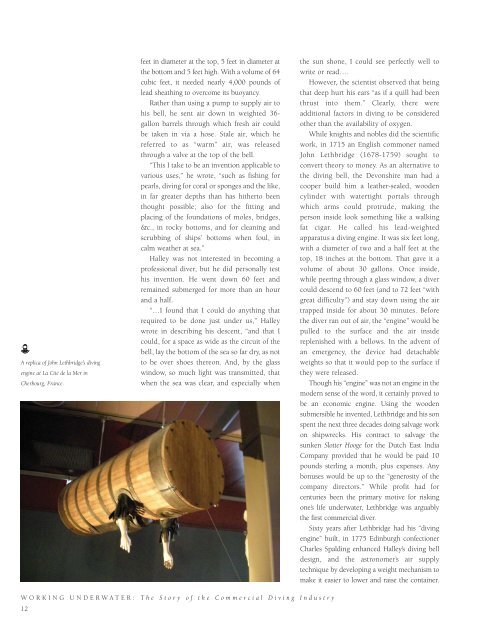Working Underwater: The Story of the Commercial Diving Industry
An illustrated history of the commercial diving industry paired with the histories of companies that have helped shape the industry.
An illustrated history of the commercial diving industry paired with the histories of companies that have helped shape the industry.
Create successful ePaper yourself
Turn your PDF publications into a flip-book with our unique Google optimized e-Paper software.
A replica <strong>of</strong> John Lethbridge’s diving<br />
engine at La Cité de la Mer in<br />
Cherbourg, France.<br />
feet in diameter at <strong>the</strong> top, 5 feet in diameter at<br />
<strong>the</strong> bottom and 5 feet high. With a volume <strong>of</strong> 64<br />
cubic feet, it needed nearly 4,000 pounds <strong>of</strong><br />
lead sheathing to overcome its buoyancy.<br />
Ra<strong>the</strong>r than using a pump to supply air to<br />
his bell, he sent air down in weighted 36-<br />
gallon barrels through which fresh air could<br />
be taken in via a hose. Stale air, which he<br />
referred to as “warm” air, was released<br />
through a valve at <strong>the</strong> top <strong>of</strong> <strong>the</strong> bell.<br />
“This I take to be an invention applicable to<br />
various uses,” he wrote, “such as fishing for<br />
pearls, diving for coral or sponges and <strong>the</strong> like,<br />
in far greater depths than has hi<strong>the</strong>rto been<br />
thought possible; also for <strong>the</strong> fitting and<br />
placing <strong>of</strong> <strong>the</strong> foundations <strong>of</strong> moles, bridges,<br />
&c., in rocky bottoms, and for cleaning and<br />
scrubbing <strong>of</strong> ships’ bottoms when foul, in<br />
calm wea<strong>the</strong>r at sea.”<br />
Halley was not interested in becoming a<br />
pr<strong>of</strong>essional diver, but he did personally test<br />
his invention. He went down 60 feet and<br />
remained submerged for more than an hour<br />
and a half.<br />
“…I found that I could do anything that<br />
required to be done just under us,” Halley<br />
wrote in describing his descent, “and that I<br />
could, for a space as wide as <strong>the</strong> circuit <strong>of</strong> <strong>the</strong><br />
bell, lay <strong>the</strong> bottom <strong>of</strong> <strong>the</strong> sea so far dry, as not<br />
to be over shoes <strong>the</strong>reon. And, by <strong>the</strong> glass<br />
window, so much light was transmitted, that<br />
when <strong>the</strong> sea was clear, and especially when<br />
<strong>the</strong> sun shone, I could see perfectly well to<br />
write or read….<br />
However, <strong>the</strong> scientist observed that being<br />
that deep hurt his ears “as if a quill had been<br />
thrust into <strong>the</strong>m.” Clearly, <strong>the</strong>re were<br />
additional factors in diving to be considered<br />
o<strong>the</strong>r than <strong>the</strong> availability <strong>of</strong> oxygen.<br />
While knights and nobles did <strong>the</strong> scientific<br />
work, in 1715 an English commoner named<br />
John Lethbridge (1678-1759) sought to<br />
convert <strong>the</strong>ory to money. As an alternative to<br />
<strong>the</strong> diving bell, <strong>the</strong> Devonshire man had a<br />
cooper build him a lea<strong>the</strong>r-sealed, wooden<br />
cylinder with watertight portals through<br />
which arms could protrude, making <strong>the</strong><br />
person inside look something like a walking<br />
fat cigar. He called his lead-weighted<br />
apparatus a diving engine. It was six feet long,<br />
with a diameter <strong>of</strong> two and a half feet at <strong>the</strong><br />
top, 18 inches at <strong>the</strong> bottom. That gave it a<br />
volume <strong>of</strong> about 30 gallons. Once inside,<br />
while peering through a glass window, a diver<br />
could descend to 60 feet (and to 72 feet “with<br />
great difficulty”) and stay down using <strong>the</strong> air<br />
trapped inside for about 30 minutes. Before<br />
<strong>the</strong> diver ran out <strong>of</strong> air, <strong>the</strong> “engine” would be<br />
pulled to <strong>the</strong> surface and <strong>the</strong> air inside<br />
replenished with a bellows. In <strong>the</strong> advent <strong>of</strong><br />
an emergency, <strong>the</strong> device had detachable<br />
weights so that it would pop to <strong>the</strong> surface if<br />
<strong>the</strong>y were released.<br />
Though his “engine” was not an engine in <strong>the</strong><br />
modern sense <strong>of</strong> <strong>the</strong> word, it certainly proved to<br />
be an economic engine. Using <strong>the</strong> wooden<br />
submersible he invented, Lethbridge and his son<br />
spent <strong>the</strong> next three decades doing salvage work<br />
on shipwrecks. His contract to salvage <strong>the</strong><br />
sunken Slotter Hooge for <strong>the</strong> Dutch East India<br />
Company provided that he would be paid 10<br />
pounds sterling a month, plus expenses. Any<br />
bonuses would be up to <strong>the</strong> “generosity <strong>of</strong> <strong>the</strong><br />
company directors.” While pr<strong>of</strong>it had for<br />
centuries been <strong>the</strong> primary motive for risking<br />
one’s life underwater, Lethbridge was arguably<br />
<strong>the</strong> first commercial diver.<br />
Sixty years after Lethbridge had his “diving<br />
engine” built, in 1775 Edinburgh confectioner<br />
Charles Spalding enhanced Halley’s diving bell<br />
design, and <strong>the</strong> astronomer’s air supply<br />
technique by developing a weight mechanism to<br />
make it easier to lower and raise <strong>the</strong> container.<br />
WORKING UNDERWATER: <strong>The</strong> <strong>Story</strong> <strong>of</strong> <strong>the</strong> <strong>Commercial</strong> <strong>Diving</strong> <strong>Industry</strong><br />
12
















